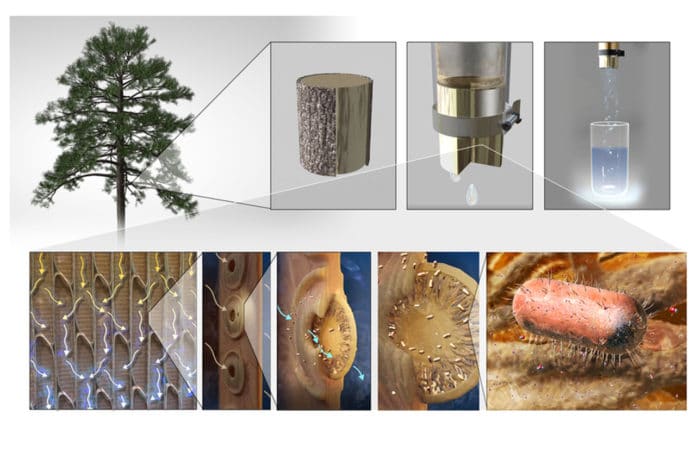Trees like pine and ginkgo have sapwood lined with straw-like channels called xylem. The function of this xylem to draw water up through a tree’s trunk and branches.
There are thin membranes that interconnect all the xylem channels together. The membranes that act as natural sieves refines bubbles from water and sap.
While understanding sapwood’s natural filtering ability, MIT engineers have previously developed simple filters from peeled cross-sections of sapwood branches. They also demonstrated a low-tech design that filters out the bacteria.
Now the same team has advanced technology- new xylem filters that can efficiently filter out the pathogens such as E. coli and rotavirus. Not only the pathogens, but the filter can also remove bacteria from contaminated springs, tap, and groundwater.
Along with this advanced filter technology, scientists also developed some techniques that increase the filter’s shelf life, hence enabling the woody disks to purify water after being stored in a dry form for at least two years.
Scientists took their techniques to India, where they made xylem filters from native trees and tested the filters with local users. Based on their feedback, the team developed a prototype of a simple filtration system fitted with replaceable xylem filters that purified water at a rate of one liter per hour.
Rohit Karnik, professor of mechanical engineering and associate department head for education at MIT, said, “Because the raw materials are widely available and the fabrication processes are simple, one could imagine involving communities in procuring, fabricating, and distributing xylem filters. For places where the only option has been to drink unfiltered water, we expect xylem filters would improve health and make water drinkable.”
In past studies, engineers found some limitations to wooden material’s natural filtering ability. As the wood dried, the branches’ sieve-like membranes began to stick to the walls, reducing the filter’s permeance or ability to allow water to flow through. Gradually with time, the filter self blocks itself- building up woody matter that clogged the channels.
Scientists came up with two simple solutions to overcome the limitations: They soaked cross-sections of sapwood in hot water for an hour. They then dipped the sapwood into ethanol and allowed it to dry. Doing this retained the filter’s permeance while efficiently filtering water without clogging up.
Scientists sliced and treated small cross-sections of white pine from branches around the MIT campus and showed that the resulting filters maintained permeance comparable to commercial filters, even after being stored for up to two years, significantly extending the filters’ shelf life.
During tests, the filter has shown the capability of removing 99 percent of contaminants such as E. coli and rotavirus.
Ramchander says, “We think these filters can reasonably address bacterial contaminants. But there are chemical contaminants like arsenic and fluoride where we don’t know the effect yet.”
The results of their filters enabled scientists to field-test their designs in India, a country that has experienced the highest mortality rate due to water-borne disease in the world.
Over two years, the engineers, including researchers in the MIT D-Lab, worked in the mountain and urban regions, facilitated by local NGOs Himmotthan Society, Shramyog, Peoples Science Institute, and Smart. They fabricated filters from native pine trees and tested them, along with filters made from ginkgo trees in the U.S., with local drinking water sources. These tests confirmed that the filters effectively removed bacteria found in the local water.
Megha Hegde of MIT D-Lab said, “One of the things that scored very high with people was the fact that this filter is a natural material that everyone recognizes. We also found that low-income people prefer to pay a smaller amount daily versus a larger amount less frequently. That was a barrier to using existing filters because replacement costs were too much.”
Scientists are now exploring ways to produce xylem filters at larger scales with locally available resources.
This research was supported, in part, by the Abdul Latif Jameel Water and Food Systems Lab (J-WAFS) at MIT and the MIT Tata Center for Technology and Design.
Journal Reference:
- Ramchander, K., Hegde, M., Antony, A.P. et al. Engineering and characterization of gymnosperm sapwood toward enabling the design of water filtration devices. Nat Commun 12, 1871 (2021). DOI: 10.1038/s41467-021-22055-w
